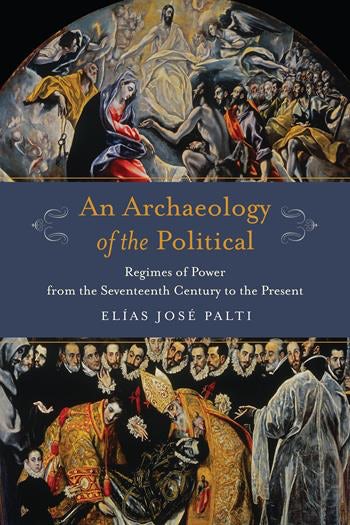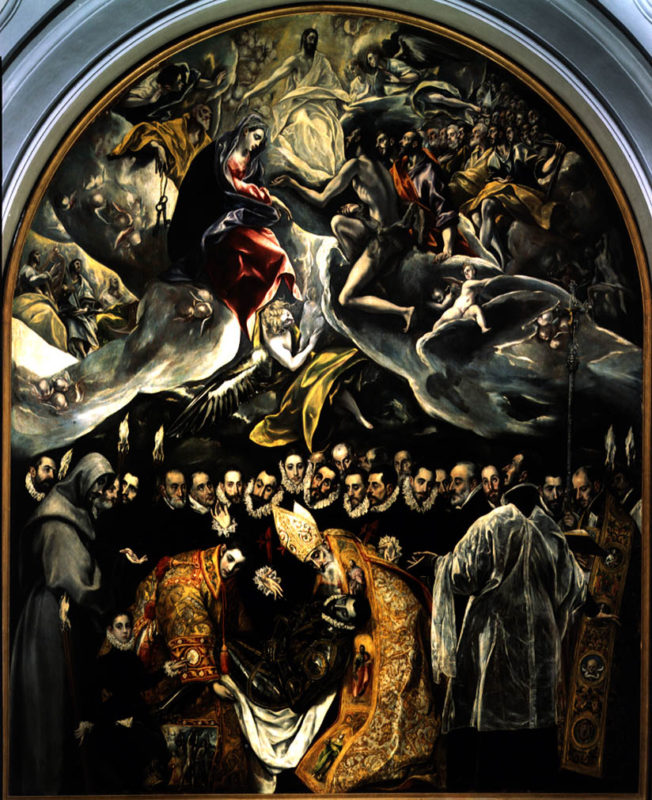The Book
An Archaeology of the Political: Regimes of Power from the Seventeenth Century to the Present (Columbia University Press, 2017)
The Author(s)
Elías José Palti

As a founding editor of Prismas, the most important intellectual history journal in Latin America today, Argentinian historian Elías José Palti is a leading figure in the field whose books are not well known in the United States despite his receiving his doctorate in history from the University of California, Berkeley. For the last two decades, Palti has been teaching in Argentina at the University of Quilmes and the University of Buenos Aires. A regular contributor to History and Theory, Palti has published many articles in English, but this volume is his first book available in the language. Among previous titles that have been vital for debates on political theory in Latin America are El Giro lingüístico e historia intelectual
(“The Linguistic Turn and Intellectual History,” 1998); El Tiempo de la política: El siglo XIX reconsiderado (“Political Time: The Nineteenth Century Reconsidered,” 2007); and El Momento romántico: Nación, historia y lenguajes políticos en la Argentina del siglo XIX (“The Romantic Moment: Nation, History, and Political Languages in Nineteenth-Century Argentina,” 2009). Palti’s new book draws upon twenty years of reflections to present a rich, critical argument about the meanings of “politics” in countries with roots in Catholic baroque Spain. The book traces concepts of sovereignty and governance from the absolute monarchies of the sixteenth and seventeenth centuries to the liberal nationalism of the nineteenth century, with a concluding essay on the dilemmas this trajectory poses for contemporary politics.
What constitutes the political has been at the center of many philosophical debates, although the valuable work of recent theorists like Claude Lefort, Jacques Rancière, Ernesto Laclau, and Slavoj Žižek ignores the historical contexts shaping political thought. They have discussed the political as an abstraction independent of time and place. In developing a conceptual history of the political, Palti’s argues that the opening of a specifically modern political horizon arose during the baroque period (1550-1750) when the distinction between immanence and transcendence disrupted the teleological Christian conception of the universe. Previous studies of this transformation in thought have emphasized the central role the Protestant Reformation played in this development, identifying the emergence of modern individualism as an important consequence. Palti’s emphasis on Catholic perspectives on the relation of immanence and transcendence that took shape in the course of the Countereformation makes his argument new and thought provoking, particularly given the centrality of concepts of community in Iberian political traditions.
Scholars have connected the rupture in understanding Catholicism as a divine gift to the rise in the West of an “age of representation,” the Baroque era of absolute monarchy, a result and expression of “the first disenchantment of the world.” The political conception justifying the unlimited power of absolute monarchs was obedience to divine command that the community be unified in submission to God and his representatives. As monarch, a king possessed a divine right to rule, even though he was a mortal man, not a divine being. The ambiguity within sovereignty gave rise to a new type of political rationality. Palti turns to El Greco’s famous painting The Burial of the Count of Orgaz (1586) how Spanish leaders understood the duality of power. Palti’s analysis of the painting emphasizes the conflict attending symbolic separation between the sacred and the profane shown in the close juxtaposition of heaven and earth, yet represented as two separate planes with the divine placed in the upper two-thirds of the canvas watching over the inferior human realm. El Greco distinguished the two realms through contrasting treatments of light, color, and tonality. The brightly colored figures of the officiating priest and his assistant connect the otherwise drab human realm to the glory of the divine. A young boy, in the lower left corner of the frame, contrasts with the otherwise self-contained and introspective nature of the scene by looking directly at viewers, drawing them into the burial scene. Perhaps, Palti suggests, the boy’s gaze reveals that this representation of divine guidance of humanity is an artifice created by El Greco.
In each chapter, Palti turns to literature, painting, theater, and music to weave the cultural context of each period covered in the book around his analysis of political theories. As the harmony between the transcendent and the immanent fell apart, the particular characteristics of modern life took shape. The theological problem of how to govern the human world in accordance with divine will transformed into a political question. New dilemmas arose, such as how to understand the political subject, as a citizen (a legal subject) or as a Christian (a moral subject). Who are we? Which is our identity? “What is the truth about who we are?” a disconcerted Pedro Calderón de la Barca asked in his play La vida es sueño (Life is a Dream, 1635), a classic of Spanish literature that is as iconic as Shakespeare’s Hamlet for its exploration of the existential dilemmas inherent to early modern political thought.
Palti concludes his study in the nineteenth century, the “age of history” emerging out of a half-century of  revolutions in the Atlantic World. Palti focuses on the new governments created in Latin America after independence to explore a determined effort by the continent’s new political leaders to overcome the dominion of the transcendent. It was a period when, independent of concepts of the sovereign, ideas of emancipation, progress, determinism, nation, and “the people” were gaining ground. A new political economy of power took shape providing the basis for the construction of a reality in which democracy appears simultaneously as a destiny and a problem because it was not clear which social group had the legitimacy to take hold of sovereign powers and build a nation. This recasting of political language required new forms for exercising authority still saturated with notions of transcendence. The Argentinean political theorist and diplomat Juan Bautista Alberdi (1810-1884), for example, stated that democracy required popular sovereignty: “Democracy resides in popular sovereignty, which is the principle compatible with all forms of Government” (quoted on p. 117).
revolutions in the Atlantic World. Palti focuses on the new governments created in Latin America after independence to explore a determined effort by the continent’s new political leaders to overcome the dominion of the transcendent. It was a period when, independent of concepts of the sovereign, ideas of emancipation, progress, determinism, nation, and “the people” were gaining ground. A new political economy of power took shape providing the basis for the construction of a reality in which democracy appears simultaneously as a destiny and a problem because it was not clear which social group had the legitimacy to take hold of sovereign powers and build a nation. This recasting of political language required new forms for exercising authority still saturated with notions of transcendence. The Argentinean political theorist and diplomat Juan Bautista Alberdi (1810-1884), for example, stated that democracy required popular sovereignty: “Democracy resides in popular sovereignty, which is the principle compatible with all forms of Government” (quoted on p. 117).
The long, complex quest for full independence in nineteenth-century Latin America eventually arrived at a political and institutional view of the nation and the people as a homogeneous whole. This process of radical immanence that demanded harmony and uniformity even where it did not exist led to historical scholarship in the twentieth century arguing that independence had not resulted in national autonomy because irrepressible social conflicts were not reconcilable with ideas of national unity as a precondition for national sovereignty. Palti insists that the idea that independence, even if it did not lead to autonomy, brought about a change in political vocabulary. Regimes of power radicalized to the point that sovereignty was erased and politics came to mean merely “statecraft.” Or it could be that politics disengaged from notions of sovereignty and by the twentieth century developed into exercises of competing wills that were at times arbitrary, unpredictable, even incoherent.
International avant-garde cultural and scientific movements of the early twentieth century expressed most clearly the impossibility of sustaining a fully deterministic ideology in a world lacking social, subjective, or ecological predictability. Palti examines Schönberg’s arbitrary musical tonalities, Duchamp’s readymades proposing that art is whatever elicits particular types of subjective response, and Hugo de Vries’s work in organic biology refuting deterministic notions of organisms as intellectual challenges demanding a radical reconfiguration of political ideas. Twentieth-century political theorists had to accept the limits of historicism. Amid an infinity of ways to understand life itself, it was no longer possible to believe in immanent social projects grounded in transcendental theory.
With remarkable erudition, Palti engages in a rich dialogue with twentieth-century and contemporary philosophers engaged in defining the political. Merleau-Ponty is particularly important for Palti’s probing of what the political could be. Palti argues that revolutionary violence exposes the tragic side of contemporary politics. Militants fighting to end social injustice adopt as their own methods of governance that they claim to overthrow, evidence against historical teleology or that there might be “good violence” that fulfils historical destiny. Palti concludes that the ethical dimensions of contemporary political conflict require acceptance of historical indeterminacy as an expression of social plurality and complexity. Palti proposes that “we are witnessing the end of the age of history and the emergence of the age of forms. The distinct mark of this age is the overcoming of the evolutionary model and the emphasis on discontinuity” (126). The goal he points to is a period in which there is constant battle against naturalized conceptions of psychology and political-juridical realities that prevent the participation in social life of those and that which normative rules label misshapen, contingent, partial, relative, and/or unassimilable to normatively defined rules and factuality.
Palti’s examines Kazimir Malevich’s painting White on White (1918) and Robert Rauschemberg’s Erased de Kooning Drawing (1953) to discuss the breaking up of historicist political horizons through art works whose possibilities for meaning rest on exposing the fluid and porous boundaries separating the immanent (a physical object) and the transcendent (ideas of art), categories that are only notionally dual, much less deterministic. The result, concluding a long historical cycle, is a second disenchantment of the world that Palti invokes to leave readers with many unresolved questions. Is it possible to understand the political as nothing more than a conceptual problem? What kinds of political practice are possible after eliminating notions of collective and subjective identity resting on immanent/transcendental distinctions? What happens when God no longer occupies the entire symbolic universe of political life but politics has no substitute foundational myths except perhaps private interest? What might be the basis for articulate a renewed sense of community? What kinds of political practice rupture the limits of what has long been considered the political? Elías Palti in presenting a genealogy of the political presents a broad but disturbing panorama to reflect upon the immense political challenges facing the contemporary world.
(translated by Richard Cándida Smith)
About the Reviewer
Priscila Dorella is an Adjunct Professor of History at the Universidad de Viçosa in Brazil. She currently is a Visiting Scholar in the Department of History at UC Berkeley.

0